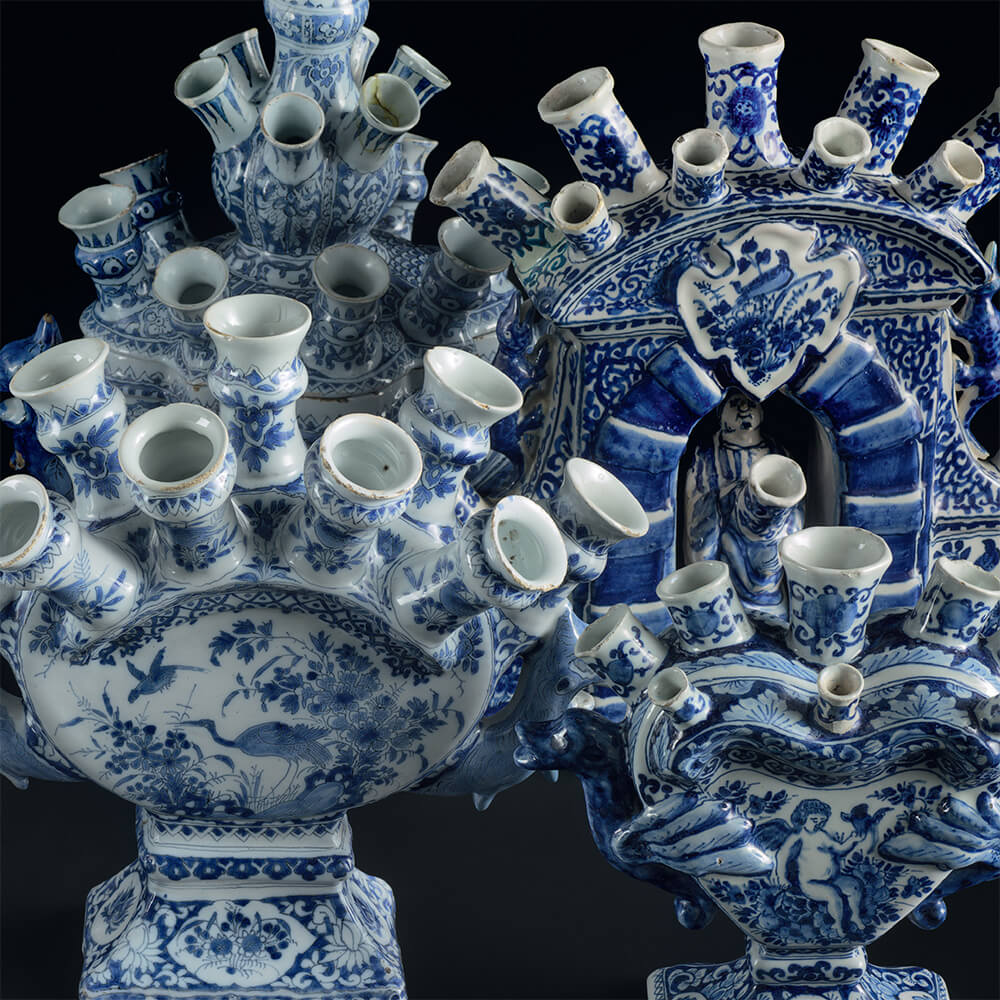Our deepest gratitude to Gemeentemuseum Den Haag for allowing us to put Het Wonder Van Delfts Blauw in cfile.library for your enjoyment. If you are a member you can view the book in cfile.library, or begin your 14-day free trial.
Click to Download your FREE DelftWare eBook Introduction

Oriental lady with a violin, De Porceleyne Byl, circa 1740
Het Wonder van Delfts Blauw
van Aken-Fehmer, Marion S. ; Eliens; Titus M.;n Lambooy, Suzzanne M. R.
Den Haag: Waanders Uitgevers, 2012
Dutch, English translations
125 Pages
Did you know that Dutch Delft pottery was conceived as an imitation of Chinese porcelain? Maybe you guessed it; the resemblance between the two wares is quite uncanny. Starting today there is a book in cfile.library that will tell the honest story of this historic and widely collected pottery movement.
During the 17th century, all things Eastern, or “oriental” as the book calls it, were revered and demanded in Holland. One might call it a craze! The Dutch first laid eyes on Chinese pottery in the 17th century when the Dutch East India Company (VOC) began to carry large quantities of porcelain goods from East to West. They not only brought ceramics, but other items as well. Eastern aesthetics caught like wildfire in Europe and the craze persisted for more than a century, with the demand increasing so fast traders could barely keep up the supply. The highest demand was for tea.

Two Bottles with ‘Long Eliza’s’ in Kangxi style, De Grieksche A, circa 1687
Something about drinking tea made the Dutch feel regal and exotic. They learned about the ritual of tea drinking all over the East and wanted a similar sophistication for themselves. The drinking of tea began in the realm of the elite, as does everything, because the cost of imported tea was high, but it soon trickled down to common people.
With the widespread circulation of tea, the Dutch wanted high class wares to sip from. They wanted something that resembled the vessels that Easterners might drink their tea from. So, the Delft potteries began to produce in great number teapots, tea cups, tea trays, sugar bowls, and even slop basins for rinsing their new wares; at first, all of it resembled China in form, color, and surface detail And of course in the style of Delft, everything was elegant and intricately painted in that incredible blue. Some potters added non-eastern touches without thinking, “Delft potteries responded to the exotic aura surrounding the beverage by using gold to decorate their teapots and cups…”

Delftware in Wanli style, large dish De Metaale Pot, 1691-1724
Like anything that started as a cheap imitation, Delftware began breathing on its own before long. Potters began to add distinguishable Dutch trademarks to their works. Whereas before they had been using Chinese floral motifs, Taoist symbols suspended on ribbons, and the Chinese symbol for longevity, the double peach; now they painted the Dutch tulip and figures with European faces. They also painted in polychrome rather than just the blue and white.

Vessels with early polychrome decoration, jar Het Moriaanshooft, circa 1685
An amusing fact about the Dutch and their counterfeit China is that the Dutch weren’t working with porcelain at all. They didn’t have access to the main ingredient in porcelain— kaolin. The Dutch were actually using Earthenware dipped in a white glaze to impersonate real porcelain. Now, that doesn’t make it easy to differentiate between the two. If you were standing in a room surrounded by a mixture of delftware and China, much of the time the only way to tell the difference would be to look for “factory marks”, the marks which tell us the pottery in which the piece was made. With the exception of unmarked pottery and occasional forgeries, this is a surefire way to know when and where your delftware was made.

Black Delft tea canister, De Metaale Pot, circa 1691
Het Wonder van Delfts Blauw not only traces the elder history of Delftware, but also the more contemporary history of Royal Delft (the only surviving Delft pottery from the early days) and Dutch design around 1900 when Dutch ceramicists found inspiration in the dripping luminescent French Art Pottery as well as the ceramic forms of the Sung Dynasty. The book even clues us into postmodern Delftware with tall forms and Dutch art deco surface designs; then navigating us to the contemporary pottery and sculpture of The Netherlands. Check out this book!

Earthenware, De Porecelyne Fles, 1925
If you are a member view the book in cfile.library, or begin your 14-day free trial.

Enjoyable document. Well done!
Terry